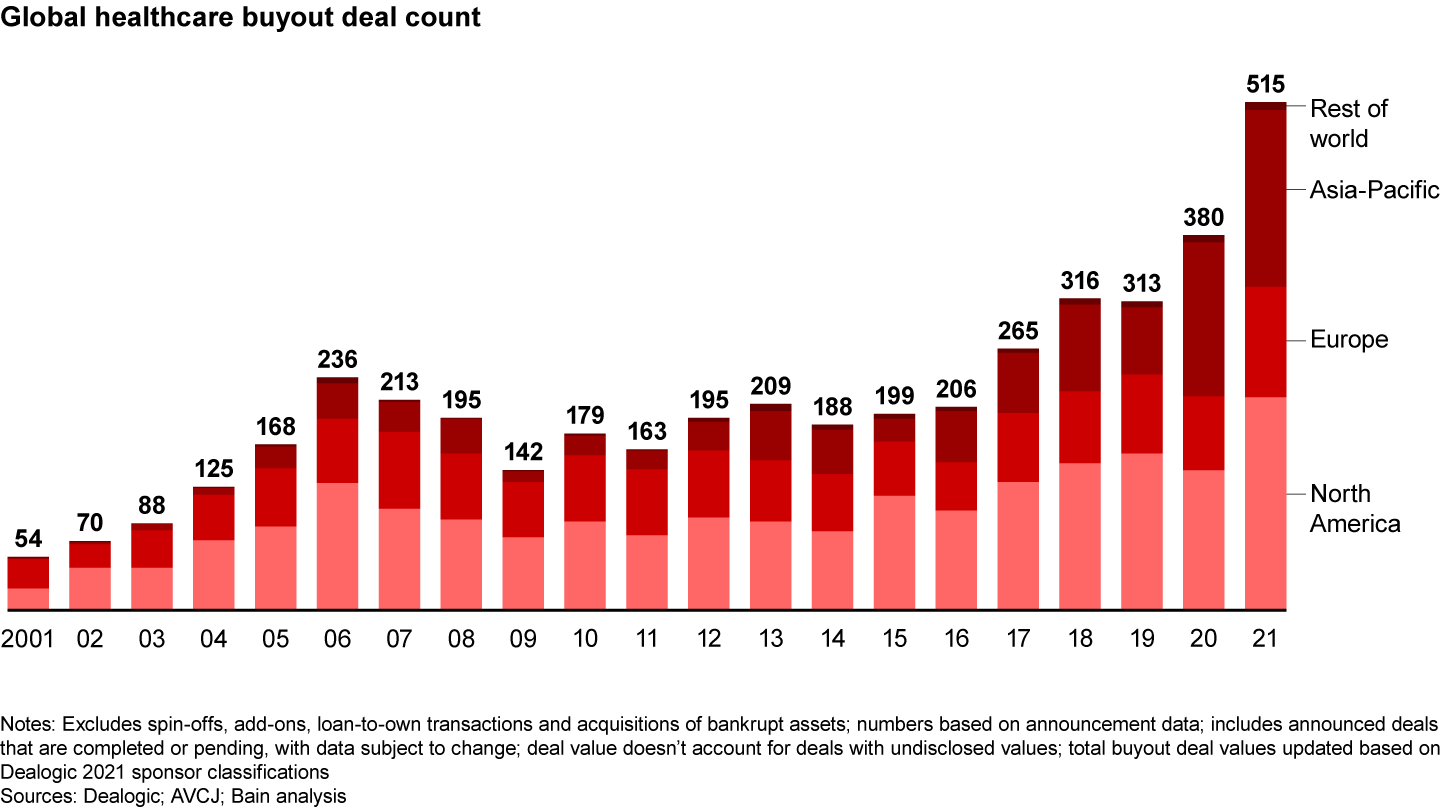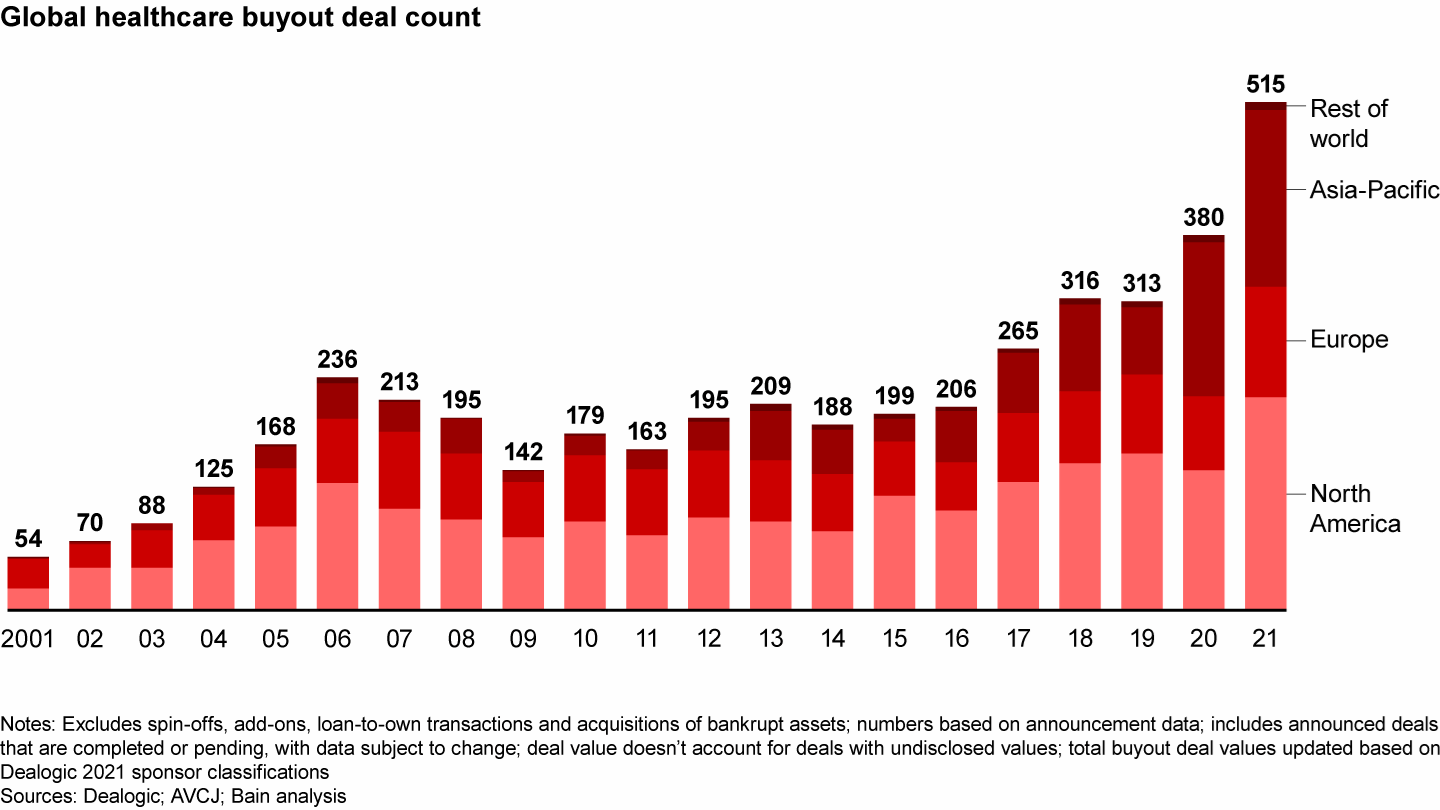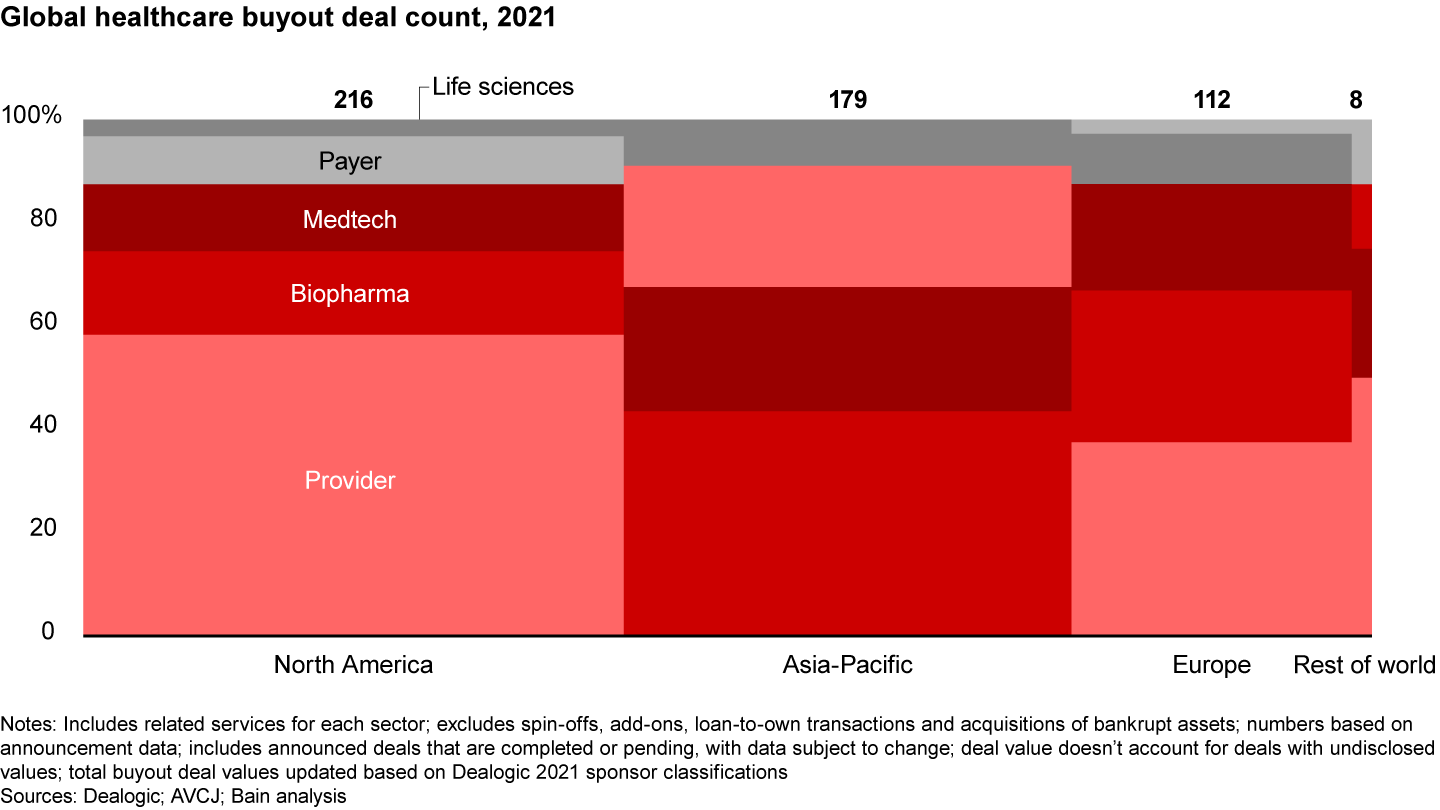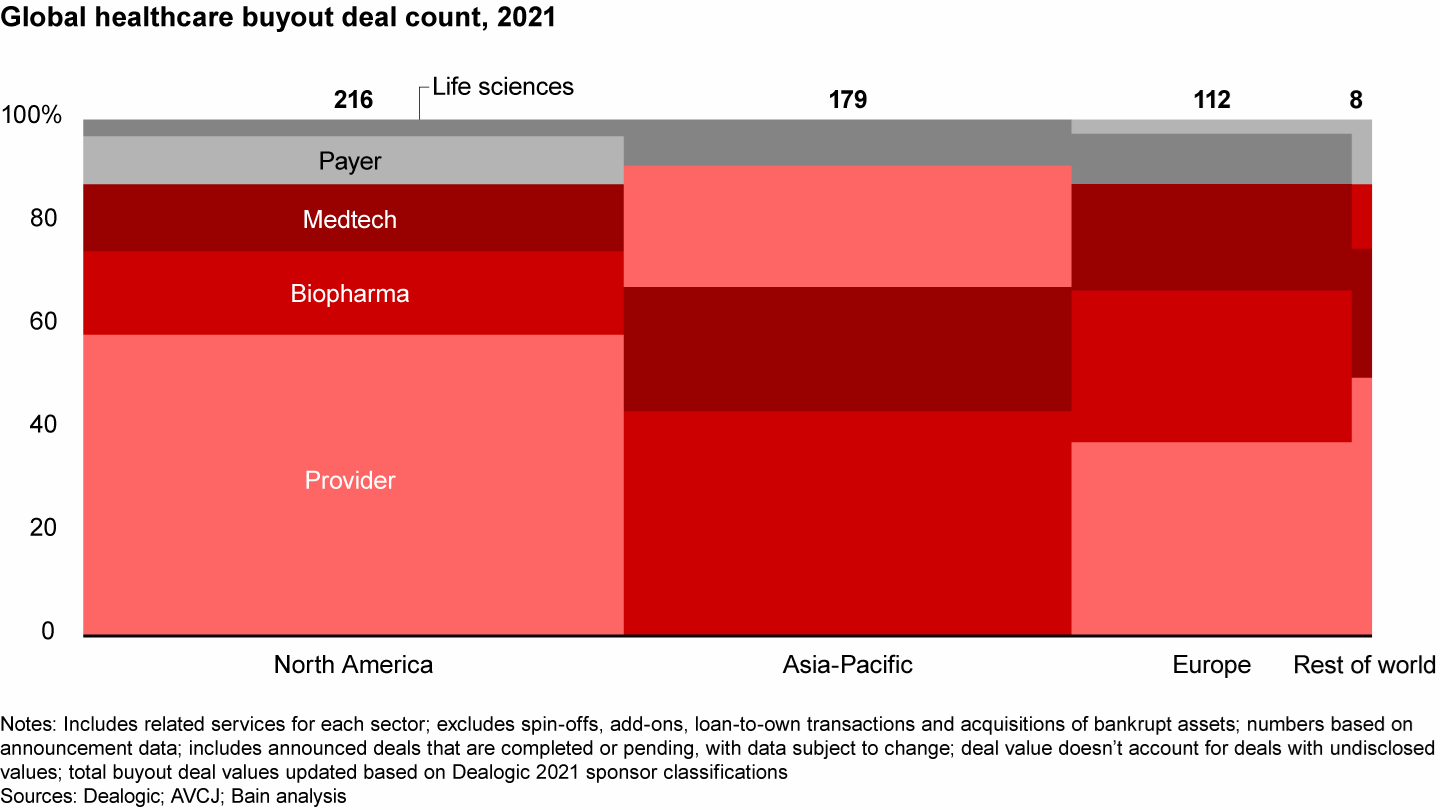Rapport

At a Glance
- North America posted record healthcare deal activity, including several megadeals.
- Providers remained the most active subsector, fueling the growth of next-generation primary care models.
- Healthcare IT activity surged as data platforms changed hands at unprecedented valuations, and growth-equity investors poured funds into digital health.
- Favorable demographic trends and a more benign regulatory environment in the US will continue to pique investors’ interest.
This article is part of Bain's 2022 Global Healthcare Private Equity and M&A Report
Despite supply chain disruptions, inflation, and the onset of Covid-19 variants raising uncertainties in the broader economy, 2021 turned out to be a record year for healthcare private equity in North America (see Figures 1 and 2). Several favorable macro trends aligned to broaden the opportunities for value creation:
- An aging population and the rising prevalence of chronic disease are driving steady growth in demand for healthcare.
- Maturing value-based payment models, more than a decade since passage of the Affordable Care Act in the US, continue to create openings for companies that reimagine care delivery with a focus on patient experience, health outcomes, and costs.
- The pandemic has accelerated the use of digital tools that use big data and machine learning in every health sector, helping to make many operations more efficient and spur innovation. The result could be better health outcomes at a lower cost.
- Since 2010, the median internal rate of return for private equity healthcare deals has consistently exceeded the all-industry median, attracting greater allocation to healthcare.
In line with these trends, private equity investors doubled down in North America during the year.
Healthcare deal activity grew in every region


North America outpaced Asia-Pacific for the most healthcare deal activity


Providers: next-generation primary care on the rise
As in prior years, the provider sector contributed the majority of deals in North America, with a record 126 deals, or 58% of the total, up from 52% in 2020. Disclosed deal value surged to an all-time high of $38.5 billion from $19.3 billion in 2020, largely due to the acquisition of Athenahealth for $17 billion.
A big shift in care delivery, particularly in the US, underpinned much of the activity. The country’s mix of huge healthcare spending, a fragmented insurance industry with large-scale commercial payers, and a high burden of chronic disease create unique value creation opportunities.
Next-generation primary care models in the US attracted a flood of private equity sponsor and corporate deal activity. The common threads are delivering a superior, often tech-driven, customer experience, along with reaching a strong position in risk-bearing payment. Retail giants and commercial payers made big strategic investments here. Walgreens Boots Alliance acquired VillageMD for $5.2 billion to accelerate its opening of at least 600 Walgreens primary care practices by 2025. Cigna, which acquired MDLive, launched virtual-first primary care health plans with select employers. And Anthem joined Blackstone Growth and K Health to form Hydrogen Health, which provides on-demand virtual primary care powered by artificial intelligence (AI).
Beyond primary care, consolidation continued in retail health and specialty physician groups. As in Europe, veterinary care attracted significant investments. For example, JAB Investors-backed National Veterinary Associates acquired Ethos Veterinary Health for $1.7 billion and SAGE Veterinary Care for $1.25 billion, two national networks of specialty veterinary clinics. Specialty dental providers attracted more investor attention than general dental firms. For instance, Harvest Partners bought Affordable Care, a US chain of denture and implant services providers, for $2.7 billion. And Thomas H. Lee Partners joined Linden Capital Partners as equal investors in orthodontics chain Smile Doctors with a $2.4 billion valuation.
Roll-ups of physician groups continued, among even more specialties. Activity remained strong in established categories such as ophthalmology and gastroenterology, while investment surged into new, more fragmented, and more hospital-owned specialties, such as cardiology and orthopedics. These specialties stand to benefit from Medicare approval to reimburse more procedures for ambulatory surgical centers (ASCs), value-based care’s growth across insurance types, and physician and patient preference for outpatient surgery centers. In cardiology, Webster launched Cardiovascular Associates of America in partnership with Cardiovascular Medicine. And in orthopedics, Welsh, Carson, Anderson & Stowe acquired Resurgens Orthopaedics.
As Covid-19 raised patient and provider acceptance of at-home care and triggered CMS’s Acute Hospital Care at Home initiative, which reimburses hospitals for inpatient-level care at home, investors found opportunities to invest in the home-based trend. Notably, Webster Equity Partners bought Honor Health Network, a Medicaid-focused home care services company, from Walnut Court Capital. And health systems Mayo Clinic and Kaiser Permanente invested $100 million in home-hospital service provider Medically Home.
Payers: improving the customer experience and tackling social determinants
Payer activity held steady at 20 deals for both 2021 and 2020, which was a big increase from prior years. Disclosed value surged to $15 billion from $4.4 billion in 2020 in the wake of three major deals: Nordic Capital, Insight Ventures, and 22C Capital’s buyout of Inovalon for $7.3 billion; CVC’s acquisition of a controlling stake in ExamWorks for $4 billion; and Veritas’s purchase of HMS Holdings for $3.3 billion.
The largely private insurance market in the US causes North America to remain the hub of global payer deals, contributing 83% of global volume and over 98% of disclosed value. Not captured in our buyout data, major US commercial payers made numerous strategic acquisitions, notably of providers, to strengthen control of the healthcare value chain as they build diversified healthcare services businesses.
Payer services deals focused on IT platforms that employ data to improve both the customer experience and health outcomes through targeted member engagement. The Inovalon deal, for instance, involves a healthcare data platform offering a range of solutions that improve member health outcomes. And on the heels of 2020 acquisitions of Altruista and The Burgess Group, Blackstone portfolio company HealthEdge acquired Wellframe, a software platform that leverages real-time member data and AI to help payers identify when and how to intervene with high-risk members.
Investors also turned to companies that tackle social determinants of health in the US. The paradox of high healthcare costs with poor health outcomes stems in part from limited spending on social services such as food assistance and housing. The growth of payment models that reward health outcomes and value, particularly for Medicare and Medicaid patients, has attracted companies that help payers and risk-bearing providers direct healthcare dollars to nonmedical social factors. For example, Unite Us, which connects patients with social services, raised $150 million to expand its nationwide social care infrastructure, in a round led by ICONIQ Growth. Also, Papa, a senior care platform that addresses loneliness, raised $60 million in a Series D round led by SoftBank.
Healthcare IT: revenue cycle management and digital health
After a dip in 2020 to 38 deals, healthcare IT (HCIT) activity rose to a record 59 deals in 2021. Disclosed value almost tripled to $35.7 billion from $13.3 billion in 2020, after the Athenahealth and Inovalon megadeals. The year also brought a sharp rise in the number of HCIT growth-equity investments. The US accounted for almost 80% of global HCIT volume and more than 90% of value, and the region’s large independent health systems, employer-sponsored insurance, and robust tech ecosystem should continue to attract an outsize share of IT-focused investment.
Revenue cycle management (RCM) infused the megadeals. Athenahealth, a cloud-based software company that offers electronic medical-record software and revenue cycle management software and services, was acquired by Hellman & Friedman and Bain Capital for $17 billion, the largest HCIT deal ever and an impressive exit for Veritas Capital and Evergreen Coast Capital, which bought Athenahealth for about $5.7 billion in 2018. On the corporate side, US payer UnitedHealth Group is set to acquire Change Healthcare, which offers RCM and clinical information exchange services, for an estimated $13 billion.
Growth-equity investments fueled the expansion of two types of North American HCIT companies: digital health platforms that contract directly with employers and AI tools that make the operations of various healthcare entities more efficient. Behavioral health-focused digital platforms benefited from strong growth-equity investor interest as demand rose for mental healthcare services.
For example, Spring Health, an app-based, on-demand mental health provider, closed a $190 million Series C round led by Kinnevik. Other digital behavioral health platforms also received growth equity funding including BetterUp, Ginger/Headspace, Lyra Health, and Modern Health. Growth equity also poured into HCIT assets that leverage big data and AI to make operations more efficient. In the provider and payer sectors, Olive, an AI-as-a-service company that automates back-end processes, raised $400 million in a round led by Vista Equity Partners and Base10 Partners. In biopharma, insitro, which uses machine learning to accelerate drug discovery and development, raised $400 million in a Series C round led by the Canada Pension Plan Investment Board.
Biopharma and life sciences: tools and services to advance therapeutics
North American biopharma and life sciences deals reached a record 42 deals in 2021, up from 28 in 2020. Deal value rose to $15.2 billion from $8.9 billion, driven by large deals including the EQT and Goldman Sachs purchase of clinical research organization Parexel for $8.5 billion, and Altaris Capital Partners' purchase of Perrigo’s generics business for $1.6 billion.
Like the rest of the world, North America saw significant investment in drug development and commercialization services. That included next-generation clinical trials, as shown by the Thoma Bravo acquisition of clinical trial software provider Greenphire, and the ERT acquisition of Bioclinica, a technology company focused on clinical trial data. In commercialization services, Welsh, Carson, Anderson & Stowe portfolio company Managed Markets Insight & Technology merged with Hg Capital portfolio company Evaluate to strengthen their leadership in pharma commercial intelligence. North America also saw notable activity in cell and gene therapies with the growth investments in Caris Life Sciences and ElevateBio.
North American life sciences deals focused on research and bioprocessing instruments as well as consumables. No major investments in diagnostic lab companies took place, despite significant investments in Europe and Asia-Pacific. Instruments powering the research underlying cell and gene therapies attracted several investments. For example, Carlyle acquired Unchained Labs, whose products streamline biologic and gene therapy research, for $435 million. And Vitruvian Capital invested in MaxCyte, whose electroporation instruments accelerate development of cell and gene therapies.
Medtech: the Medline buyout dominates deal value
Deal volume in the region rose modestly to 28 in 2021, up from 19 the year prior, while disclosed deal value surged to $38.8 billion from $2 billion in 2020, because of the $34 billion Medline megadeal, the largest healthcare buyout ever.
Similar to other regions, North America featured large investments in assets that make medical equipment more reliable and cost-effective. As providers face continued pressure to reduce costs, investors spotted ways to help, such as the Medline deal, and the $1.3 billion buyout of PartsSource. And Hellman & Friedman acquired cardiology and endovascular devices manufacturer Cordis from Cardinal Health.
Nevertheless, private equity continues to face stiff competition from strategic buyers, suppressing the opportunities for medical technology assets.
Demographic and regulatory tailwinds
The tailwinds propelling North American healthcare assets show no sign of abating. Demographic trends, notably an aging population and increasing rates of chronic disease, will persist. The region’s high healthcare spending, commercial payer landscape, technology ecosystem, and dynamic capital markets create unique opportunities for innovators. Moreover, we expect the more benign regulatory environment will continue, as will the uniquely favorable reimbursement landscape in the US. As a result, we anticipate acceleration of several trends that have already garnered investor interest.
- Advanced primary care models that improve on patient experience, whole person health outcomes, and costs will grow rapidly, putting pressure on large brick-and-mortar health systems to reimagine how they deliver care.
- Value-based care plays will extend beyond primary care to specialty care, redesigning the management of all sorts of conditions to deliver better health outcomes at a lower cost.
- Care will continue to shift out of the hospital to ASCs, as well as patient homes and mobile devices, redefining how patients interact with care.
- The line between payers and providers will blur further, as more companies try to capture the profit and health-outcome synergies of delivering and financing care together.
- Innovation in cell and gene therapies, along with mRNA and other platform technologies, will spur growth in biopharma and life sciences while delivering hope to patients suffering from previously untreatable conditions.
- Across the industry, assets that leverage data and AI to streamline operations will gain ground.